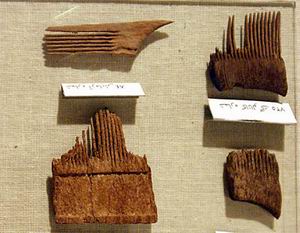A little known report dated to January 31, 2005 cites the Iranian Cultural heritage News agency’s discovery of the world’s oldest known ruler. This was unearthed in 2005 at the Shahr e Sookhteh or Burnt City near Zabol in Iran’s southeast province of Sistan-Baluchistan.
The Burnt City, dated to 5000 years ago, is perhaps one of the ancient world’s most advanced urban centers. The site indicates that advanced urban centers and accompanying technology in Western Asia did not necessarily originate in the Mesopotamian and/or Levant arenas. Western scholars have worked alongside their Iranian colleagues for a number of years to conduct excavations at the Burnt City and elsewhere on the Iranian plateau.

A display of the thousands year old Rulers (or pieces of the same ruler) discovered at Shahr e Sookhteh (Burnt City). The device made of ebony wood, has a precise system of measurement whose units correspond to 1.5 millimeters (Source: CHN & Payvand News).
Dr. Mansour Sajjadi, the head of the excavation team, told CHN reporters that:
“During the recent excavations, we found a piece of ebony wood 10-centimeter long with some cuts which have evidently been made with a sharp tool. After carrying out the necessary tests and studying the wood under microscope, we found out that the cuts were divided in one millimeter and half millimeter measures…”
This precise system of measurement indicates that the inhabitants of the Burnt City were highly advanced in the sciences, mathematics and civil construction works. The discovery of the ancient ruler is suggests that the inhabitants of the Burnt City probably had developed other precise measurement tools. The Burnt city has already yielded interesting finds such as an artifical eye, backgammon pieces, and an example of animation.



